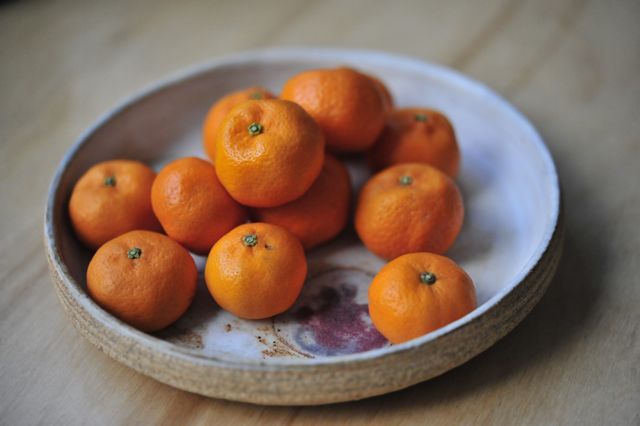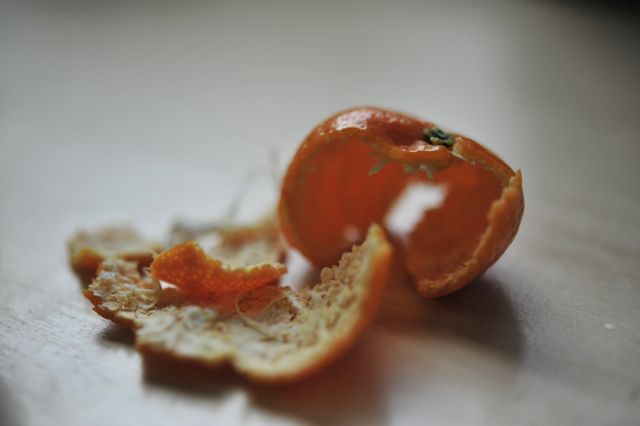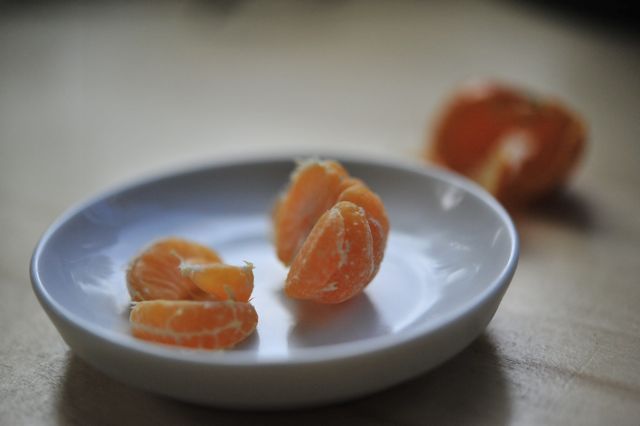2.22.11 Kishu? I Don't Even Know You!
I come from a very linguistically focused family where all sorts of word games (not to mention mind games) were the order of the day. I'm very into language and its limitless possibilities for manipulation, including the humblest pun. Never can resist. Ingredients are sort of like words, able to be tossed together in seemingly infinite combinations, so that cooking becomes a kind of jazzy poetry (rap?!) or improvised narrative. The kishu is a sweet little grace note, an ampersand between clementines and satsumas. This tiny mandarin, only slightly bigger than a jawbreaker, originated in China and arrived in Japan around the 17th century, where it is known as mukaku-kishi. Mukaku means seedless, which they are. They have a super-short season and are not that easy to come across. I got mine through Local Harvest, a locavore network that helps you find farmers' markets, family farms and other sources of sustainably grown food in your area, and through which you can buy produce, grass-fed meats and other coveted items. My kishus came from Churchill Orchard, a small organic farm in Ojai, California.
Kishus are the perfect combination of sweet and tart. If you can stop yourself from popping them whole into your mouth, you can enjoy each firm, juicy little segment like a delectable candy. Alex Raij, the chef at Txikito in Manhattan, is also a fan. Last week, New York magazine published her recipe for a carpaccio made with very thinly sliced kishus (clementines make a worthy substitute), fanned out over a citrus-infused caramel, drizzled with olive oil and finished with a light sprinkling of crunchy sea salt. This inspired juxtaposition of flavors and textures is easily replicated by you as the perfect end to a rich meal, or for a delightful Sunday afternoon treat.CLEMENTINE CARPACCIO WITH CITRUS CARAMEL, SEAT SALT & OLIVE OILfrom Alex Raij at Txikitoserves 412 seedless clementines (or 4 times as many kishus), plus 4–6 more to yield 1 cup juice
Juice of 1 lemon
1 cup sugar
1/8 teaspoon salt
1/4 cup fresh Spanish olive oil (preferably Navarran Arbequina)
Crunchy sea saltPeel 12 clementines by hand, reserving peel from three. Chill fruit. Combine fruit juices and strain.Julienne the peels and place in a small pot, along with sugar. Cover with 2/3 cup water. Stir once and heat on medium-high flame. Boil until the caramel turns dark chestnut, then add citrus juices very carefully. Whisk the mixture and stir in salt. Let cool slightly or entirely at room temperature, but do not chill. To serve: Place 1 1/2 tablespoons of the caramel on each of 4 plates.Using a very sharp knife and no pressure, thinly slice the peeled fruit crosswise into 1/8- to 1/4-inch-thick wheels. Arrange in a petal pattern over the caramel without overlapping. Drizzle with olive oil, and sprinkle a tiny amount of sea salt on each slice.
Juice of 1 lemon
1 cup sugar
1/8 teaspoon salt
1/4 cup fresh Spanish olive oil (preferably Navarran Arbequina)
Crunchy sea saltPeel 12 clementines by hand, reserving peel from three. Chill fruit. Combine fruit juices and strain.Julienne the peels and place in a small pot, along with sugar. Cover with 2/3 cup water. Stir once and heat on medium-high flame. Boil until the caramel turns dark chestnut, then add citrus juices very carefully. Whisk the mixture and stir in salt. Let cool slightly or entirely at room temperature, but do not chill. To serve: Place 1 1/2 tablespoons of the caramel on each of 4 plates.Using a very sharp knife and no pressure, thinly slice the peeled fruit crosswise into 1/8- to 1/4-inch-thick wheels. Arrange in a petal pattern over the caramel without overlapping. Drizzle with olive oil, and sprinkle a tiny amount of sea salt on each slice.









4 Comments